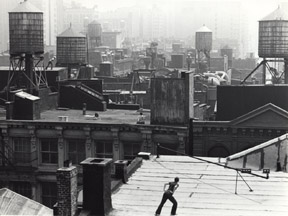| About Roof Piece | |||||||||||||||||||||||||
| How I Made Some of My Films | |||||||||||||||||||||||||
| The Making of Water Motor | |||||||||||||||||||||||||
| Living Somewhere | |||||||||||||||||||||||||
| Collecting as a Creative Process (coming soon...) | |||||||||||||||||||||||||
|
About Roof Piece a dance by Trisha Brown and a photograph by Babette Mangolte For Trisha the choreography was testing how improvised movements appear at a distance and are transformed by transmission by a succession of dancers mimicking with variation what they see and how what has been transmitted at one end is different when received at the other end. The dance tested the erosion of movement by transmission as in telegraphy. It also was about revealing the majesty and privacy of downtown roofs and the sculptural effect of its water towers. The dance was made of improvised movements influenced by the series Accumulation and Group Primary Accumulation choreographed by Trisha Brown in 1972 and 1973, and how dancers positioned about a block apart over a large distance transmitted those movements. The distance was the numbers of city blocks in New York City from West Broadway and Houston to White Street and Church at the other end. Altogether the distance was seven blocks north to south and three blocks west to east. The movement was improvised by Trisha Brown facing south and seen by the dancers closer to her facing North. Trisha was sending the movement down the line to Carmen Beuchat at the receiving end on White Street. After 15 minutes Trisha ducked below the ledge of the roof signaling to all the dancers on their rooftops that it was time for them to face South to be ready to transmit the movement originated by Carmen Beuchat on White Street back to Trisha Brown on the receiving end of the line. The total piece was two times fifteen minutes or thirty minutes plus duck-time. I suggested to Trisha that the best way to document the piece was to film with three 16mm cameras the head and tail end of the line and an intermediary view of a long shot with the rooftops. At the time they was no way to synchronize three film projectors but I felt that three filmed views were the only way to prove the erosion of the movement by comparison over the thirty minutes of the performance by placing side by side the head and tail of the line. The three film rolls were shot on reversal color Kodachrome film stock and Trisha had dressed all the dancers in red so they would be highly visible for the audience that had several rooftops to gather, including the ones where the dancers were situated. There was no place from where you could see it all. Actually the dance piece could be seen only in retrospect through recording and replay. Wherever you were, even from far away, you saw specks of red here and there. Nowhere could you see it all. We loaded each camera with 1200 feet load or about 33 minutes of screen time, so once started the cameras were left to document in static shots what would happen. Trisha raised the money to shoot the dance with three cameras and the three films were only formally assembled as DVD display synchronized and side-by-side in Art, Lies and Videotapes, Exposing Performance at Tate Liverpool curated by Adrian George in 2003. I shoot one roll of black and white photographs during the 30 minutes dance and the contact sheet printed on 16 by 20 inches paper, in its 24 frames, reveals the haphazardness of it all. Only one photograph from the roll was reproduced at first in the New York Times, then immediately in many other places making the photograph well known and this image is now considered to be the embodiment of the New York downtown art scene from the 1970s. When examining why this singular photograph is so powerful you notice that the dancer in the foreground is seen from the back looking at the vista in front of her and echoing in her movement the line of the roof where she stands. Two large water towers seem to dominate left and right of the space. The dancer is Silvia Palacios-Whitman and she is looking south so the photo was taken in the second half of the dance. You also quickly and at a second glance notice that other dancers are there on rooftop and have the same diagonally curved bodyline. When you look very attentively you can count at least three more dancers that recede in the haze of a July day. But it is because the photo is in black and white that the effect is so strong. The dancer’s body is just other speck of gray, almost like an afterthought. Black and white erases the dancers and highlights the display of the New York roof architecture seen as glistening white roofs and massive water tower that dwarf the bodies. The dance was set outdoors on rooftops and was performed twice on June 24 and on July 1, starting at 2 PM. I took the photograph and organized the shooting of the three cameras shoot on the July 1 performance and it is also then that I took my most famous photograph.For Trisha, Babette Mangolte, July 2007 |
